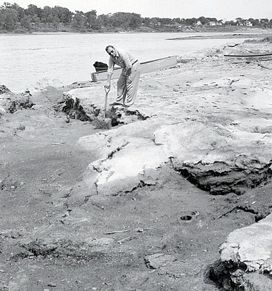 Fibre mats on the Rainy River 1952For those of us living at the north end of Lake of the Woods, the Rainy River is a two hour car drive away and perhaps not familiar to us, but this river is the most influential tributary to Lake of the Woods, contributing about 70 per cent of the total water flowing into the lake. This week, we take a look at a bit of the fascinating history of the cleanup of the Rainy River – which has had a direct impact on the health of Lake of the Woods.
Fibre mats on the Rainy River 1952For those of us living at the north end of Lake of the Woods, the Rainy River is a two hour car drive away and perhaps not familiar to us, but this river is the most influential tributary to Lake of the Woods, contributing about 70 per cent of the total water flowing into the lake. This week, we take a look at a bit of the fascinating history of the cleanup of the Rainy River – which has had a direct impact on the health of Lake of the Woods.
In the 1800s, Alexander Mackenzie called the Rainy River one of the finest rivers in the North West. As newspapers became more popular leading up to the First World War, the river was seen as a perfect location for a paper mill and two were built on either side of the river in Fort Frances, ON and International Falls, MN. The ensuing discharge of pollutants from the paper making process from the 1920s to the 1960-70s had a drastic impact on the river’s health – large quantities of wood chips, fine particulate matter and organic compounds led to what’s seen (and what’s not seen) in these photos – shocking amounts of wood fibre mats downstream of the mills in 1952.
Sewage and other domestic wastes added to the mix. By the late 1950s, pollution of the Rainy River was dire enough for both Canada and the United States to bring in the International Joint Commission to study the problem and, ultimately in 1966, to establish an international pollution board for Rainy River to pressure the governments to make much needed changes. From this point in time, steep declines in pollutants occurred, total phosphorus being one of them.
In 2011, Kathryn Hargan, in a research project supported by the Lake of the Woods Water Sustainability Foundation, estimated that the two largest sources of phosphorus to the Rainy River are Rainy Lake and the Little Fork River. Point sources include seven municipal sewage treatment plants and the two pulp and paper mills. The two mills at the time were the largest human source of phosphorus to the Rainy River at about 16 per cent. Phosphorus concentrations generally increase in a downstream direction in the Rainy River due to additional non-point sources from agricultural runoff and erosion. Even with all this, the total phosphorus loads to the Rainy River have declined dramatically since the 1960s.
Recent data from the Minnesota Pollution Control Agency (2014) show 86 per cent decreases in total phosphorus and 75 per cent decreases in Total Suspended Solids between 1953 and 2010. In data collected by Environment Canada, the number of times that water quality criteria was exceeded for total phosphorus declined from 68 per cent for the period between 1979-1985 to 19 per cent for the period between 2009 and 2011.
So, what does this significant cleanup mean for Lake of the Woods, especially because we know that total phosphorus and algae are linked? That’s the topic for next week… be sure to check in!
– Kelli Saunders, M.Sc., is the International Watershed Coordinator with the Lake of the Woods Water Sustainability Foundation
